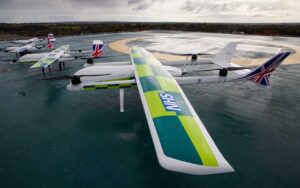
Drones could soon be deployed for NHS deliveries, offshore wind turbine inspections and supply missions to oil rigs under sweeping changes to the UK’s drone regulations planned for 2026.
The government is preparing to allow drones to fly beyond the operator’s visual line of sight (BVLOS), a major step that would unlock long-distance missions across remote or hard-to-reach areas. Currently, drones in the UK must remain within direct sight of their pilots, limiting their use to short-range tasks.
Lord David Willetts, chair of the newly launched Regulatory Innovation Office (RIO), told The Guardian that the changes could go live as early as 2026, initially applying to “atypical” aviation environments. This means drones would first be authorised to operate in remote, rural or offshore areas — far from the complexities of congested urban airspace.
“There’s a clear market for commercial drone operators, but the benefits to services like the NHS are even more compelling,” said Willetts. “Drones could carry urgent medicines, deliver samples and support frontline care in remote communities.”
Regions such as the Scottish Highlands and offshore islands could be among the first to benefit, Willetts suggested, with drones used to deliver medication to GP surgeries and collect blood samples for testing. The NHS is already trialling drone transport between Guy’s and St Thomas’ hospitals in central London, in collaboration with drone startup Apian and Alphabet-owned company Wing. Similar pilot programmes have launched in Northumberland.
The government is investing £16.5 million in the Civil Aviation Authority to build a regulatory framework for BVLOS drone operations. This will pave the way for drones to take on more complex tasks — from delivering vital supplies to enhancing public safety through surveillance in the government’s Safer Streets initiative.
“You could imagine drones being used by police forces to monitor public areas or respond quickly in remote locations,” Willetts said, adding that expanding the definition of “atypical” airspace could allow greater flexibility for drone flights across large swathes of UK airspace.
Before drones can operate in busier skies, however, significant progress will be needed in aircraft detection and communication systems. These technologies would be critical for safely integrating drones alongside commercial and private aircraft.
Willetts also pointed to major potential in offshore applications. “Using drones to inspect wind turbines or resupply oil rigs is currently limited by line-of-sight restrictions,” he explained. “But with the right rules in place, these operations could be done faster, safer and more cost-effectively.”
Technology Secretary Peter Kyle welcomed the proposals, saying the changes would position Britain at the forefront of drone innovation. “Cutting red tape so drones can safely deliver supplies or inspect offshore wind turbines without costly workarounds like putting someone in a boat — that’s exactly the kind of progress the Regulatory Innovation Office is here to deliver,” he said.
If implemented, the reforms could open up new commercial markets, increase efficiency in public services, and transform how the UK manages infrastructure, healthcare logistics and emergency response in remote areas.
Read more:
Drones set to deliver NHS supplies and inspect offshore sites under new UK rules by 2026






